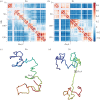Structural aspects of the inactive X chromosome
- PMID: 28947656
- PMCID: PMC5627159
- DOI: 10.1098/rstb.2016.0357
Structural aspects of the inactive X chromosome
Abstract
A striking difference between male and female nuclei was recognized early on by the presence of a condensed chromatin body only in female cells. Mary Lyon proposed that X inactivation or silencing of one X chromosome at random in females caused this structural difference. Subsequent studies have shown that the inactive X chromosome (Xi) does indeed have a very distinctive structure compared to its active counterpart and all autosomes in female mammals. In this review, we will recap the discovery of this fascinating biological phenomenon and seminal studies in the field. We will summarize imaging studies using traditional microscopy and super-resolution technology, which revealed uneven compaction of the Xi. We will then discuss recent findings based on high-throughput sequencing techniques, which uncovered the distinct three-dimensional bipartite configuration of the Xi and the role of specific long non-coding RNAs in eliciting and maintaining this structure. The relative position of specific genomic elements, including genes that escape X inactivation, repeat elements and chromatin features, will be reviewed. Finally, we will discuss the position of the Xi, either near the nuclear periphery or the nucleolus, and the elements implicated in this positioning.This article is part of the themed issue 'X-chromosome inactivation: a tribute to Mary Lyon'.
Keywords: X chromosome; X inactivation; chromatin; nucleus.
© 2017 The Authors.
Conflict of interest statement
We declare we have no competing interests.
Figures


References
Publication types
MeSH terms
Substances
Grants and funding
LinkOut - more resources
Full Text Sources
Other Literature Sources
